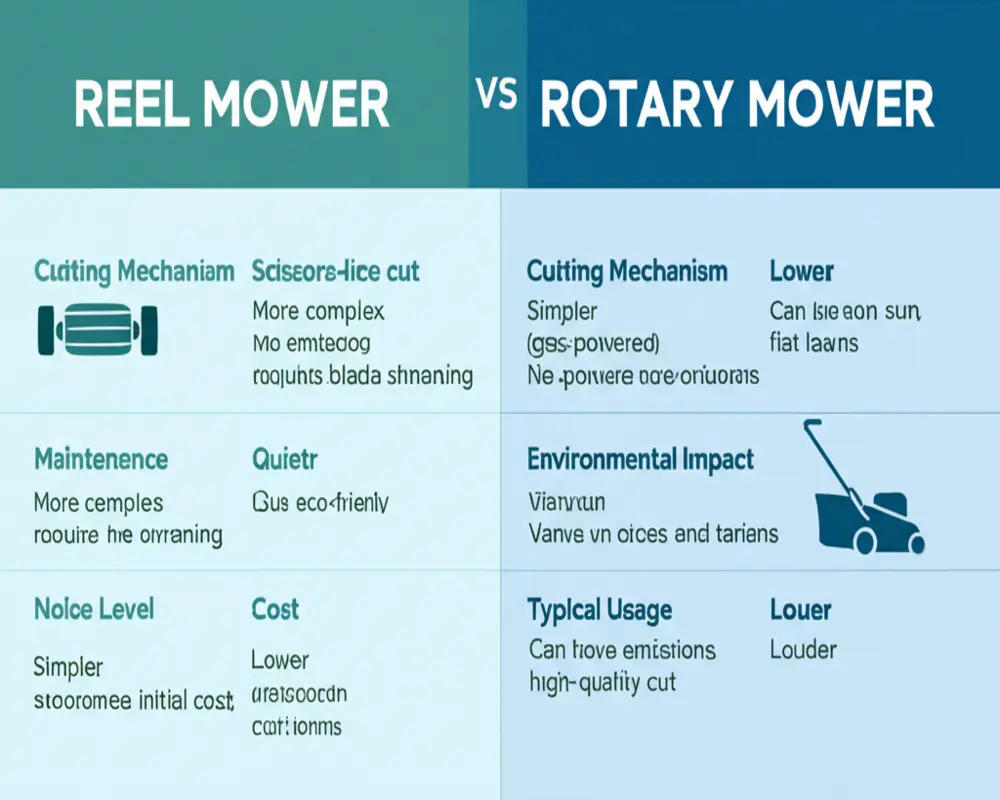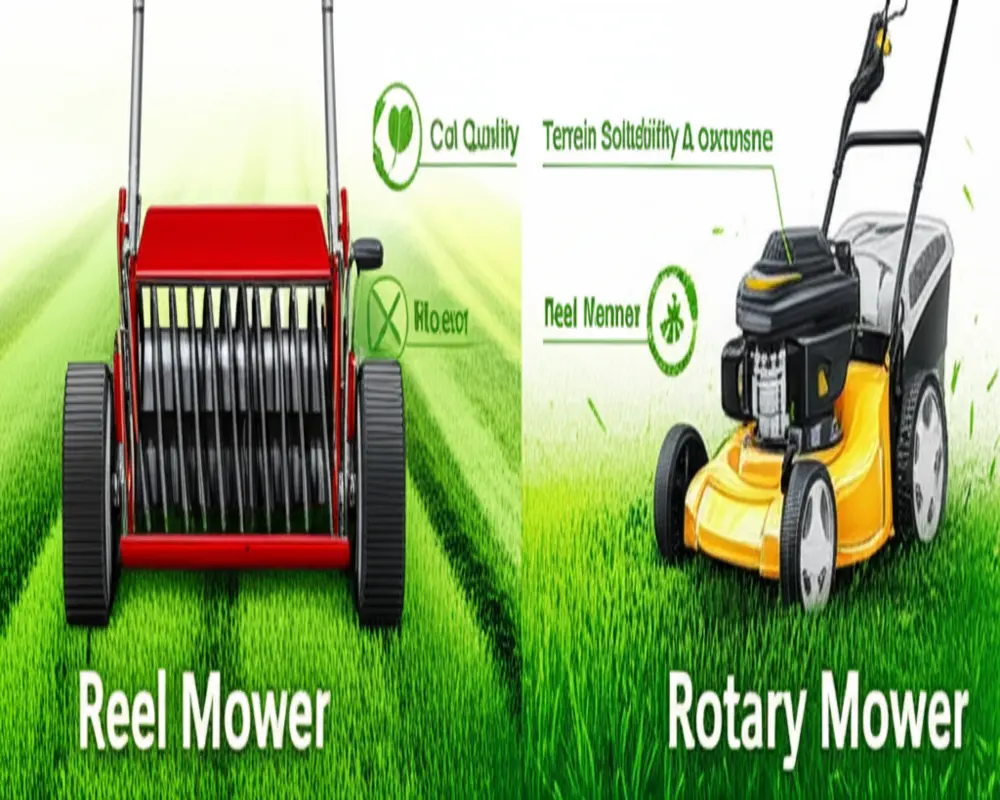Reel Mower vs Rotary Mower: Which Is Best for Your Lawn in 2025?
Choosing the right lawn mower is fundamental for maintaining a healthy and attractive lawn. With advancements and evolving preferences, the debate between the reel mower vs rotary mower continues to be relevant in 2025. Both types offer unique advantages and are designed for different needs and lawn conditions. This article provides a detailed comparison to help you make an informed decision that aligns with your lawn care goals.
Thank you for reading this post, don't forget to subscribe!Quick Comparison Chart: Reel Mower vs Rotary Mower at a Glance
Before we dive deeper, here’s a quick overview that summarizes the key differences between reel and rotary mowers:
| Category | Reel Mower | Rotary Mower |
|---|---|---|
| Cut Quality | Clean, scissor-like cut with striped lawn appearance | Blade tears grass, may cause tip damage |
| Lawn Type | Best for low-cut grasses, warm and cool season | Suitable for most grass types, including tall and tough grass |
| Lawn Size | Ideal for small to medium flat lawns | Suitable for all sizes, including uneven terrain |
| Maintenance | Requires specialized sharpening and lubrication | Easier blade sharpening, plus engine care for gas models |
| Cost | Generally lower for manual types, no fuel costs | Wide price range, ongoing fuel or electricity expenses |
| Ease of Use | Lightweight and quiet, but can be tiring on large lawns | Heavier but faster, designed for overgrown or rough grass |
| Noise & Environment | Zero emissions, very quiet operation | Gas models noisy; electric versions quieter but still emitting some noise |
| Safety | Lower risk with cutting mechanism | Higher risk from high-speed spinning blades |
| Terrain | Best on flat lawns | Handles uneven and rough terrain well |

Understanding Each Mower Type
What is a Reel Mower?
A reel mower features a set of helical blades arranged in a cylinder that spin vertically, cutting grass much like scissors by shearing it cleanly. This precise cutting mechanism preserves the health of the grass and promotes a neat, striped aesthetic.

Reel mowers come in three primary types: manual, electric, and gas-powered. Manual reel mowers rely solely on human power, offering an eco-friendly and noise-free option. Electric and gas variants provide more power and ease of use but with added maintenance requirements. Their key features include:
- Precise, clean cuts ideal for low-cut grass
- Best suited for warm-season and cool-season grasses
- Environmentally friendly, especially manual and electric types
What is a Rotary Mower?
Rotary mowers operate using a horizontally spinning blade that cuts grass by impact and tearing. This mechanism allows rotary mowers to handle taller, tougher, or uneven grass more effectively than reel mowers.

Types of rotary mowers include gas-powered, electric, and robotic models. The versatility of rotary mowers makes them a popular choice for various lawn sizes and conditions. Their notable features include:
- Ability to cut tall, thick, or weedy grass
- Mulching capabilities to recycle grass clippings
- Suitable for rough, uneven terrain
Head-to-Head Comparison
Cut Quality & Lawn Health
The reel mower offers a cleaner cut, shearing grass blades like scissors, which helps maintain lawn health by reducing the risk of disease and promoting a striped appearance favored by many lawn enthusiasts. In contrast, rotary mowers cut by tearing or chopping, which can damage grass tips and lead to a less polished look.
Suitability for Grass Types & Aesthetics
Reel mowers excel on grasses that thrive when kept short, such as Bermuda and fescue, which are common warm-season and cool-season grasses. The rotary mower, however, can accommodate a wider variety of grass types and is effective for lawns where higher cut heights are preferred or necessary due to grass growth patterns.
Lawn Size & Terrain
For small to medium-sized, flat lawns, reel mowers provide an excellent solution due to their lightweight nature and clean cut. However, rotary mowers are better suited for larger properties and uneven or rugged terrain, where their power and cutting mechanism can handle tougher conditions with ease.
Maintenance & Durability
Maintaining a reel mower requires specialized sharpening of the helical blades and regular lubrication to ensure smooth operation. Rotary mowers generally require less specialized sharpening, but gas-powered versions demand routine engine maintenance. Electric rotary mowers simplify upkeep but still require occasional blade care.
Cost Considerations
Manual reel mowers are typically the most affordable option upfront and incur no fuel costs, making them economical for small lawns. Rotary mowers present a broader price range, with gas models often costing more initially and accumulating additional expenses through fuel and maintenance.
Ease of Use & Maneuverability
Reel mowers are lightweight and quiet, which is ideal for small areas. However, pushing a manual reel mower over large lawns can be tiring. Rotary mowers, while heavier, operate faster and are effective for overgrown or dense grass, reducing mowing time.
Environmental Impact & Noise
Reel mowers, especially manual and electric types, produce zero emissions and operate quietly, enhancing environmental sustainability and neighborhood tranquility. Gas-powered rotary mowers generate noise and emissions, although electric rotary models mitigate noise levels but still consume electricity.
Safety
The mechanical design of reel mowers poses a lower risk of injury as the blades move slowly and are less likely to cause accidents. Rotary mowers, with their high-speed spinning blades, present a greater safety risk and require careful handling.
When to Choose a Reel Mower
If you maintain a small, flat lawn with grasses that thrive at low cut heights and prioritize environmental friendliness and quiet operation, a reel mower is an excellent choice. Pros include superior cut quality and minimal noise, while cons encompass physical effort and limited terrain capability.
When to Choose a Rotary Mower
For larger or uneven lawns, or where grass is tall or weedy, a rotary mower offers the power and versatility needed. It is also preferable if you require faster mowing and mulching options. Pros include adaptability to various terrains and grass types, with cons related to noise, emissions, and potentially higher maintenance.
Key Factors to Consider Before Buying
Before purchasing, evaluate your lawn’s size and terrain, grass type and desired cut height, your available time and effort for mowing, budget constraints, and environmental and storage considerations. Matching these factors with the mower type ensures optimal lawn care results.
Common Misconceptions & FAQs
Are all reel mowers manual?
No, reel mowers come in manual, electric, and gas-powered versions, each offering different levels of ease and power.
Can rotary mowers achieve striped lawn look?
While rotary mowers can create striped patterns with roller attachments, the effect is generally less crisp compared to reel mowers due to the cutting mechanism.
How often should blades be sharpened?
Reel mower blades typically require sharpening every 20-25 hours of use, whereas rotary mower blades may need sharpening less frequently depending on usage and terrain.
Electric rotary vs gas rotary mower: which is better?
Electric rotary mowers are quieter and eco-friendlier with lower maintenance, ideal for small to medium lawns. Gas rotary mowers offer greater power and longer run times, suited for larger or more rugged lawns.
What is the difference between bagging and mulching?
Bagging collects grass clippings for disposal, while mulching finely chops them to decompose on the lawn, providing nutrients and reducing waste.
Conclusion: Making Your Final Decision
Ultimately, the choice between a reel mower vs rotary mower comes down to your specific lawn characteristics and personal preferences. Reel mowers offer precise cuts and environmental benefits ideal for smaller, well-maintained lawns. Rotary mowers provide versatility and power for larger, more challenging terrains and grass types. By aligning your selection with your lawn size, terrain, grass species, and maintenance capacity, you ensure a healthier, more beautiful lawn that meets your expectations for years to come.
For more detailed insights on garden tools and techniques, visit our digging spade technique guide and explore expert advice to enhance your gardening experience.
External references used for this article include trusted sources such as The Spruce, LawnStarter, and Extension.org, ensuring the information is accurate and current.

